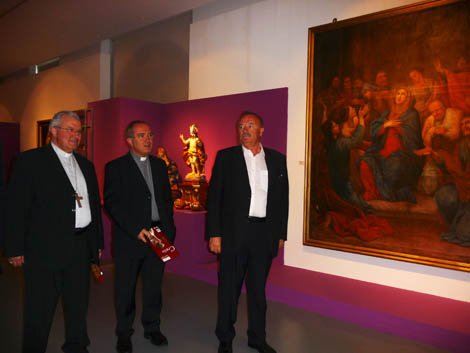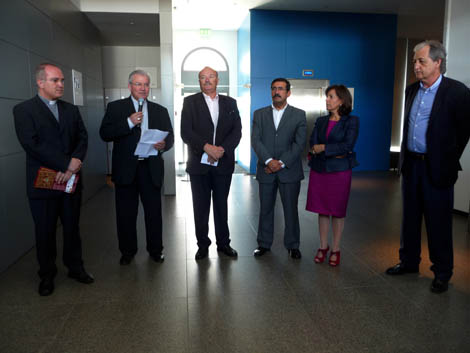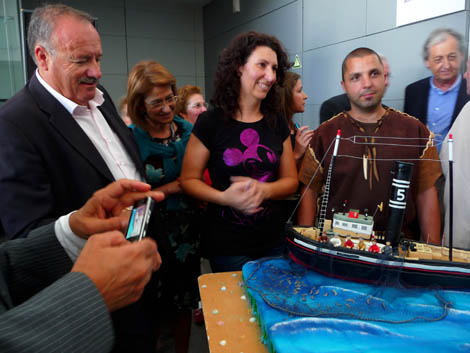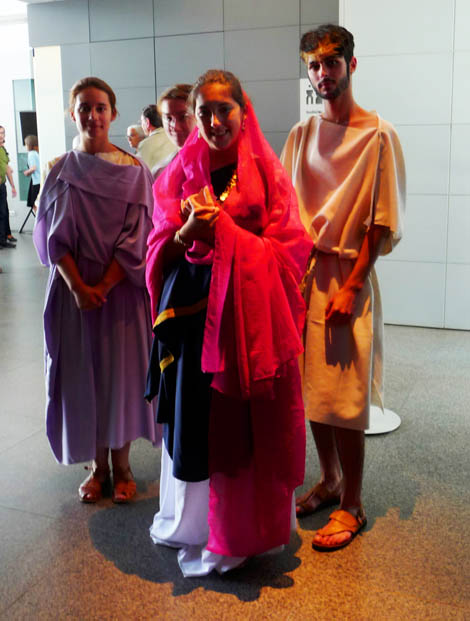 «Through the itinerary of more than 50 exhibits, coming from all over the Algarve, even from the mountains, [we can] learn about the importance of this cultural and religious heritage and what it represents in the expression of faith of the Algarve people». That is how D. Manuel Neto Quintas, Bishop of the Algarve, described the exhibition «Creio», which this Saturday, the 25th, opened at the Museu de Portimão.
«Through the itinerary of more than 50 exhibits, coming from all over the Algarve, even from the mountains, [we can] learn about the importance of this cultural and religious heritage and what it represents in the expression of faith of the Algarve people». That is how D. Manuel Neto Quintas, Bishop of the Algarve, described the exhibition «Creio», which this Saturday, the 25th, opened at the Museu de Portimão.
«"I believe"It is a simple title in its formulation, but profoundly dense in its content," added Bishop Manuel.
Manuel da Luz, mayor of Portimão, for his part, began by noting that "everyone knows that I have an affective and effective relationship with the Church", and then added: "but that is not the only reason for the municipality get involved in an exhibition of this nature'.
Citing Habermas and Dostoievsky, among other authors, the mayor stressed that "religious heritage is a founding, structuring element" of Europe, and recalled the role he defends for Portimão, as an "educating city", which educates for "peace, freedom, conviviality, the humanization of things and structures”, in short, that “privileges citizenship”.
 The exhibition is, according to Manuel da Luz, «an unmissable opportunity to contemplate expressions of utopia». «The Municipality of Portimão is proud and sees itself in this unique cultural event», concluded the mayor.
The exhibition is, according to Manuel da Luz, «an unmissable opportunity to contemplate expressions of utopia». «The Municipality of Portimão is proud and sees itself in this unique cultural event», concluded the mayor.
The inauguration of the exhibition, which was attended by dozens of people, which completely filled the room, was followed by a performance by the choir of the Igreja Matriz in Portimão, led by conductor António Alves.
It was then the turn of a visit commented on by Father Mário Sousa, the parish priest of the Matriz de Portimão, to whom, deep down, we owe the idea of this exhibition, which is unprecedented, as the most important and significant pieces of the sacred art heritage of the Algarve.
…the roman coin
At the end of the visit, and after Faustina, the wife of Emperor Marcus Aurelius, having wandered around the Museum, accompanied by a Greek slave and two of his ladies, it was time to present the coin to the public for the first time. Roman gold plate known as «Aureus de Faustina», found in the Arade bed in 1970, during dredging in the river, but only now returned to its original location, the city of Portimão.
«Oh… so little!», was the exclamation that was most heard, when finally, in a prominent showcase in the Museum's atrium, the beautiful gold coin, around two thousand years old, was exposed. Small, in fact, but very beautiful, justifying, in itself, a visit to the Museum.
…the cake
 Finally, to mark the 5th anniversary of the Portimão Museum, which this Saturday, May 25th, was celebrated, the giant cake emerged, once again out of the artistic hands of two Museum employees – Vera Santos and Nuno Silva.
Finally, to mark the 5th anniversary of the Portimão Museum, which this Saturday, May 25th, was celebrated, the giant cake emerged, once again out of the artistic hands of two Museum employees – Vera Santos and Nuno Silva.
Representing a trawler in the middle of a sardine task, the cake was received with applause…and enjoyed with even greater satisfaction. Although there were those who even thought that it was "a bad job to eat such a beautiful cake".
…the Photo Race
Meanwhile, throughout the day, the 13th Portimão Photographic Race, which gathered close to 150 competitors. The departure was at 9:00 am from the Museum and the return was also there, at 20:00 pm, counting, in the middle, with a passage through the main points of the three parishes of the county. In a few months you will see the result of this day's photographic work, under very hot sun.
One more word for Faustina and her entourage. The wife of Roman Emperor Marco Aurélio was incarnated by Rita Araújo, who was accompanied by a Greek slave (Francisco Vicente), and two Roman ladies (Beatriz Andrade and Andreia Costa).
The four young actors are interns in the professional course Technician of Performing Arts – Interpretation at the Pinheiro e Rosa Secondary School, in Faro, supervised by Professor Ana Cristina Oliveira, under the Collaboration Agreement between the Regional Directorate of Culture of the Algarve and that entity. The same students are responsible for the staged visits that take place in the Roman ruins of Milreu, in Estoi (Faro).
Veja more photos in the gallery on facebook.



















Comments